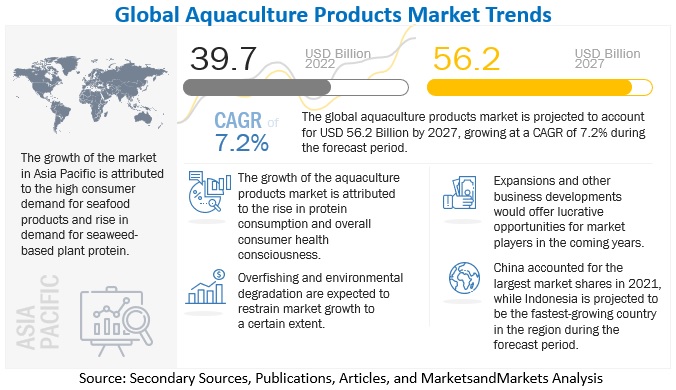The global aquaculture products market is experiencing rapid growth, fuelled by the rising demand for seafood, technological innovations, and a shift toward sustainable food production. As one of the fastest-growing segments in the food industry, aquaculture is vital for addressing global protein needs while reducing pressure on wild fish stocks. This article examines the major trends, opportunities, and challenges shaping the aquaculture products market today.
Aquaculture Products Market Overview
Aquaculture, or fish farming, involves breeding, rearing, and harvesting aquatic organisms like fish, shellfish, seaweed, and algae. The aquaculture products market encompasses live fish, fish feed, specialized equipment, pharmaceuticals, and industry-specific services.

Recent market research indicates that the global aquaculture market is set to grow at a compound annual growth rate (CAGR) of approximately 7.2% from 2022 to 2027. The Asia-Pacific region leads the market, driven by its extensive coastline, supportive government policies, and increasing domestic seafood consumption.
Aquaculture Products Market Trends
- Increasing Demand for Protein-Rich Diets: The rising global population and growing preference for healthier, protein-rich diets are boosting the demand for aquaculture products. Seafood, particularly fish and shellfish, is seen as a healthier alternative to red meat, contributing to its growing popularity.
- Advancements in Technology: Innovations such as automated feeding systems, water quality monitoring sensors, and advanced breeding techniques are revolutionizing aquaculture practices. These technologies enhance efficiency, reduce waste, and improve yields.
- Sustainability and Eco-Friendly Practices: Awareness of environmental conservation is driving the adoption of sustainable aquaculture practices. Certifications like ASC (Aquaculture Stewardship Council) and BAP (Best Aquaculture Practices) are increasingly required for market entry in many regions.
- Diversification of Product Categories: The market is expanding beyond traditional seafood products to include algae-based supplements, ornamental fish, and aquaculture-derived pharmaceuticals. Algae farming, in particular, is gaining traction for applications in biofuels, cosmetics, and dietary supplements.
Aquaculture Products Market Opportunities
- Emerging Markets: Regions like Africa and Latin America offer untapped potential for aquaculture expansion due to favorable climates, abundant water resources, and growing urban populations.
- Value-Added Products: The demand for ready-to-eat and processed seafood products is rising, creating opportunities for businesses to develop value-added product lines.
- Innovative Aquafeed Solutions: Alternative protein sources for fish feed, such as insect meal and plant-based proteins, are addressing sustainability concerns and reducing reliance on traditional fishmeal and fish oil.
- Digital Aquaculture: The integration of IoT (Internet of Things) and AI (Artificial Intelligence) is enabling “smart farming” in aquaculture. These digital solutions optimize operations, improve profitability, and enhance resource management.
Aquaculture Products Market Future Outlook
Innovation, sustainability, and collaboration will shape the future of the aquaculture products market. Governments, private enterprises, and research institutions must work together to address industry challenges and meet global food demands.
Investments in research and development, sustainable practices, and digital technologies will drive the next wave of growth. With strategic planning and execution, aquaculture can play a pivotal role in creating a sustainable and secure global food system.
Aquaculture Products Market Regional Analysis
The aquaculture products market is a vital segment of the global food industry, encompassing a range of goods and services essential for the cultivation of aquatic organisms. These products include feed, equipment, fertilizers, pharmaceuticals, and other supplies required to sustain the growth of the aquaculture sector. Regional analysis of this market provides valuable insights into the unique trends, challenges, and opportunities present in various parts of the world.
North America
North America is a significant player in the aquaculture products market, driven by advanced technologies, high consumer demand for seafood, and increasing investment in sustainable aquaculture practices. The United States and Canada dominate the regional market, with a focus on species such as salmon, trout, and shellfish. Key trends include:
- Adoption of recirculating aquaculture systems (RAS) for sustainable production.
- Rising awareness of eco-friendly practices and certifications.
- Expansion of aquafeed production tailored to meet specific nutritional needs.
Europe
Europe is another prominent market for aquaculture products, known for its stringent regulations and commitment to sustainability. Norway, Scotland, and Greece are major contributors, with salmon and sea bass being the most commonly farmed species. Regional highlights include:
- Strong support from government policies and initiatives.
- Advanced breeding and hatchery technologies.
- High demand for organic aquaculture products.
Asia-Pacific
The Asia-Pacific region holds the largest share of the aquaculture products market, driven by countries such as China, India, Indonesia, and Vietnam. This region’s dominance is attributed to its favorable climatic conditions, abundant water resources, and significant government support. Notable aspects include:
- Massive production of shrimp, carp, and tilapia.
- Rapid growth of small-scale and large-scale aquaculture enterprises.
- Increasing adoption of innovative farming techniques, such as integrated multi-trophic aquaculture (IMTA).
Latin America
Latin America has emerged as a growing market for aquaculture products, with Chile, Brazil, and Ecuador leading the way. The region is renowned for its salmon, shrimp, and tilapia production. Key drivers include:
- Access to vast coastal areas and freshwater resources.
- Rising export opportunities to North America and Europe.
- Investments in sustainable aquaculture projects.
Middle East and Africa
The Middle East and Africa (MEA) region is gradually gaining traction in the aquaculture products market, supported by efforts to reduce reliance on imported seafood and enhance food security. Egypt, Saudi Arabia, and South Africa are notable contributors. Regional characteristics include:
- Growth in freshwater aquaculture for tilapia and catfish.
- Government initiatives to boost aquaculture production.
- Challenges related to water scarcity and infrastructure development.
Request for Sample pages: https://www.marketsandmarkets.com/requestsampleNew.asp?id=2224024